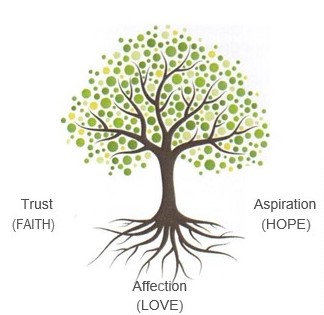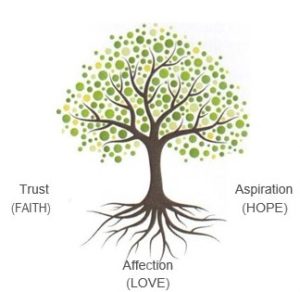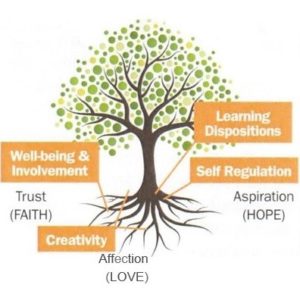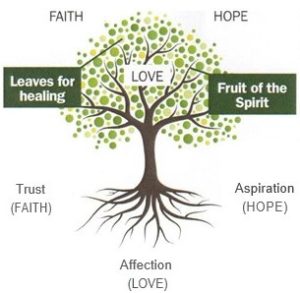
A model for Christian early education. The reader is invited to consider the whole work of early years and take in the full scope of what is happening in the life of a little person.
“To climb a new tree means to the boy the discovery of a new world.” (Froebel) Trees have had an important place in my own work with young children. I have encouraged and supported so many little people in clambering up tree trunks and branches. Froebel’s insight was perfectly correct. The world looks different from the top of the tree. From that perch a boy or girl has a different perspective and it is enabling and thrilling. The Bible makes many references to trees and The Tree.
And out of the ground the Lord God made to spring up every tree that is pleasant to the sight and good for food. The tree of life was in the midst of the garden, …. (Genesis 2:9)
… on either side of the river, the tree of life with its twelve kinds of fruit, yielding its fruit each month. The leaves of the tree were for the healing of the nations (Revelation 22:2)
They put Him to death by hanging Him on a tree (Acts 10:39)
He Himself bore our sins in His body on the tree, that we might die to sin and live to righteousness. (1 Peter 3:24)
A most suggestive reference to the tree is found at the beginning of the great hymnbook of Israel:
He is like a tree planted by streams of water that yields its fruit in its season, and its leaf does not wither. In all that he does, he prospers. (Psalm 1:3)
In context , this is said of the man who walks not in the counsel of the wicked,
nor stands in the way of sinners, nor sits in the seat of scoffers; but his delight is in the law of the Lord, and on His law he meditates day and night. (Psalm 1:1-2)
But we may legitimately take it as a picture of the little person who we nurture in our early years establishments. He or she is like a sapling tree. The challenge of the imagery is beautifully expressed: Imagine a thriving garden filled with many flowers and plants, a tranquil place of aroma and colour where everything blossoms and flourishes. Envisage what conditions this oasis would require, what it would take to nurture the plants, to develop their fullest potential. And then imagine that, instead of plants, the garden is filled with children, all different and unique, all rich in potential. What conditions would they need to grow and develop? (1)
1. The soil
The soil is the crucial environment in which the sapling tree is rooted. That environment for growth is not just about the physical conditions of a building and equipment, or even the garden where children play. It is much more relational. I taught a little girl who one day spotted damsons in the grass. She wanted to collect them and found a suitable receptacle. She picked up all she could find and then realised that they had fallen from a tree. She picked from the branches those that were in reach. Then she asked to be lifted up to access those higher. She insisted on being lifted higher and higher to collect as many as she could. Eventually, I was gripping the calf of her legs and she was balancing while at the same time dextrously using her fingers to pick and store in the palm the fruit. She clambered down and joyously sang the name by which she knew me: “Mr Peter, Mr Peter, Mr Peter.”
Observe in this narrative some significant features.
1. Trust: the child trusted the adult to be able to lift her high and to keep her safe. In fact, the teacher was confident in the child’s ability to be able to balance and use the perch.
2. Aspiration: the child knew exactly what she wanted to achieve and was determined to succeed. Also, the teacher, in offering the necessary support, was motivated by a desire for the child to achieve her objective.
3. Affection: the child enjoyed a warmth towards the teacher and that affection was expressed in her triumph song at the end of the story. The affection was undoubtedly reciprocated.
Here then we see a powerful combination of the relational traits of trust, aspiration and affection. They correspond to the New Testament triad of grace: faith, hope and love. These are the environment we provide for learning and development , the soil for the growth of the sapling.
2. The roots
Some will recall the Principles poster that came with the original publication of the Early Years Foundation Stage (EYFS). Strikingly the (then six) areas of learning and development were consigned to the bottom right hand
corner of the display. Taking precedence were relationships and the environment, which we have represented here as the soil for our sapling tree. Into that soil go the plant’s roots. The roots are what the child brings to the learning process: the characteristics of effective learning (2) . Although we say that this is what the child brings, it is nevertheless the case that we support the development of those characteristics, just as the soil nourishes the growth of the roots of a plant. We should begin with reference to well-being and involvement because without this essential root health learning will be very limited and possibly superficial. When children first come to our establishments our priority must be well-being and involvement. Ferre Laevers characterises well-being as when the child is like ‘a fish in water’ as opposed to out of water, and involvement as being in a ‘state of flow’ (3) Then there is the range of what are sometimes called learning dispositions (4) . In particular, we note the place of self regulation and creativity. Once our children are enjoying high levels of well-being and involvement we can concentrate on the all-important faculty of self-regulation . For some children this is more difficult than others. Our nurture of this ‘root’ for learning must take priority over a narrow focus on the seven ‘areas of learning and development’ of the EYFS (5). The two-year old will undoubtedly be learning things of mathematical significance , but more fundamental to all learning will be self-regulation. So at that young age we might not regard measurement of progress in maths a necessity, but careful monitoring of self regulation will be crucial as we seek to support the child’s development. Once we see good levels of self-regulation we will focus our interest on the child’s creativity. Measurement of these dispositions with a reasonable degree of objectivity is not only possible but desirable . Pete Moorhouse offers a tool for monitoring creativity.(6)
3. The trunk and branches
In our scheme, the trunk and branches represent the primary and specific areas of learning of the EYFS. The growth of these cannot be ignored, of course. Nevertheless , it can readily be seen that before they can develop healthily, the roots must be firmly embedded in the soil. Equally, it is to be observed that the areas of learning are not an end in themselves. If we plant a tree in the garden and all that can be shown for our labour is a trunk and branches, we will be most disappointed. A certain man had a fig tree planted in his vineyard, and he came seeking fruit on it and found none. Then he said to the keeper of his vineyard, “Look, for three years I have come seeking fruit on this fig tree and find none. Cut it down; why does it use up the ground?” But he answered and said to him, “Sir, let it alone this year also, until I dig around it and fertilise it. And if it bears fruit, well. But if not, after that you can cut it down.” (Luke 13: 6-9)
We expect there to be leaves and fruit. For that reason we will not delay, lingering on the seven areas, but we shall move on to consider the leaves and fruit.
4. The leaves and fruit
The plays of childhood are the germinal leaves of all later life; for the whole man is developed and shown in these, in his tenderest dispositions, in his innermost tendencies. The whole later life of man, even to the moment when
he shall leave it again, has its source in the period of childhood – be this later life pure or impure, gentle or violent, quiet or impulsive, industrious or indolent, rich or poor in deeds, passed in dull stupor or in keen creativeness,
in stupid wonder or intelligent insight, producing or destroying, the bringer of harmony or discord, of war or peace. (7)
We have to ask what it is that makes for an educated, or even ‘successful’, human being. Surely competence
in literacy and maths alone are not the point. We would suggest that the harvest that we seek is ultimately one of character. We will only be content if we find in the lives of our children virtues such as faith, hope and love. Above all love will be in evidence. Commending the values of Friedrich Froebel, his friend and exponent, Baroness Bertha von Marenholtz-Bulow writes: “The conquest of self-seeking EGOISM is the most important task of education, for selfishness isolates the individual from all communion and kills the life-giving principle of love. Therefore the first object of education is to teach to love… “(8) Note well that the fruit corresponds to the soil in which the tree grows. The fruit falls and becomes the very substance that nurtures healthy growth and a future harvest.
Implications
The model of the tree has implications for the work of the pedagogue. We might well see our role as that of the gardener. Alison Gopnik expresses it like this:
Perhaps the best metaphor of all for understanding our distinctive relationship to children is an old one. Caring for children is like tending a garden… We create a protected and nurturing space for plants to flourish. It takes hard labour and the sweat of our brows, with a lot of exhausting digging and wallowing in manure. (9)
We will pay much attention to the nurseryman’s task with regard to the roots of the tree. Especially in the early days of working with a child we must ensure a good environment for nurture and child development. We cannot neglect the ‘learning and development’ of the child, but the purpose of the project will always concern what is borne by the branches of the tree. And let it not be forgotten that we are only gardeners; it is God who gives the increase. (10)
Peter Michell




